
The Artist and the Road Less Traveled – Mary Martin
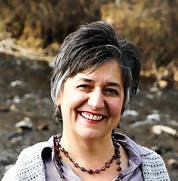
Mary Martin
Mary Martin’s journey as an artist and gallery owner took an unlikely, unconventional path. She was creative as a child and had talented, supportive, artistic parents who encouraged her creativity. She also was inspired by a beloved, grade-school art teacher, who regularly took her students’ projects home for her artist-husband to see and comment on (no names, of course). He regularly chose the work of Mary and one other student as having the greatest potential. However, a high-school art teacher who was discouraging and dismissive of her work led Mary away from an initial career in art. She ultimately decided to study physical therapy (PT) in college and to make PT her career.
Yet, it’s funny how the twists and turns in life can lead us in different directions. Years later, a barter arrangement between an artist and physical therapist with whom Mary shared an office opened the door to seven years of study with that artist. Upon learning about her colleague’s barter arrangement at the time, Mary said, “My ears perked up. How could I get in on that deal?” The artist was gracious enough to let Mary sit in on the other therapist’s art lessons, which took place a couple of times per month.
Their lessons began with drawing, but, after a while, Mary felt like she was just copying others’ work. From there, the two women transitioned to paper making and collage, where they learned a lot of different techniques for putting marks on paper. They also tried their hands at watercolor, but neither student really gravitated toward the medium. However, the moment Mary began playing with fluid acrylics, she knew she was onto something—she was having a lot of fun. Turns out that fluid acrylics act like watercolors but have the permanence of acrylics. Mary reveled in the versatility of what fluid acrylics could do. She painted a wide variety of different papers, then did collage with the painted paper. Along the way, she learned about value, shape, and color and how to put them together to create a good composition.
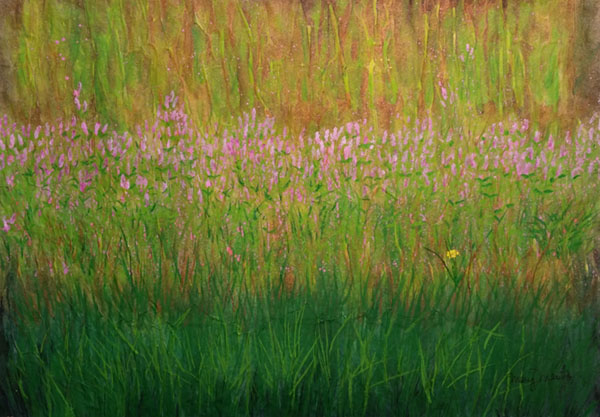
Prairie Flower Melody by Mary Martin
An additional technique Mary learned was thinning out fluid acrylics even more, then floating them on tissue paper. Something just resonated with her. That’s what she’s stayed with–not trying to compose anything in particular but getting color on paper, then using that paper to create collage. That’s where Mary says, “I took what my teacher taught me and made it my own.”
While maintaining a full-time physical therapy practice, Mary continued to take classes from the same artist in collage and different paper-making techniques. She also began participating in art workshops and art conferences. Finally, one day, Mary’s art teacher said, “You could do this, you know. You could be an artist.” Mary was shocked. As she shared in a recent interview, “Part of my journey has been that people have seen things in me that I didn’t see in myself. Just seeing that they’re seeing this [my artistic abilities] in me made me think—if someone else thinks I can do it, I guess I can. So, I would just kind of go for it.”
Indeed, the same thing happened three more times, with an arts director of a gallery housed in a local house of prayer, which turned into the first exhibit into which Mary was juried (2012); a high-school friend and admissions director of Stephens Institute of Business and Arts in Saint Louis, which produced her first solo exhibit (2014); and, recently, the founders of Green Door Art Gallery in Webster Groves, Missouri, who tapped her to purchase and helm the gallery (2018).
In fact, it wasn’t until 2012 and Mary’s first exhibit that she decided, “I’m an artist.” Her oldest son was in college and her youngest son was a junior in high school. By the time her youngest child went to college, Mary didn’t have intense, day-to-day family responsibilities. She continued working in physical therapy and loved her job treating patients. However, it was getting harder and harder to keep up with all the craziness of insurance and regulations. She asked herself how quickly she could transition out of PT and just be an artist. With fewer responsibilities for her children and the complete support of her husband (always behind her 100%), Mary decided it was time to become a full-time artist.
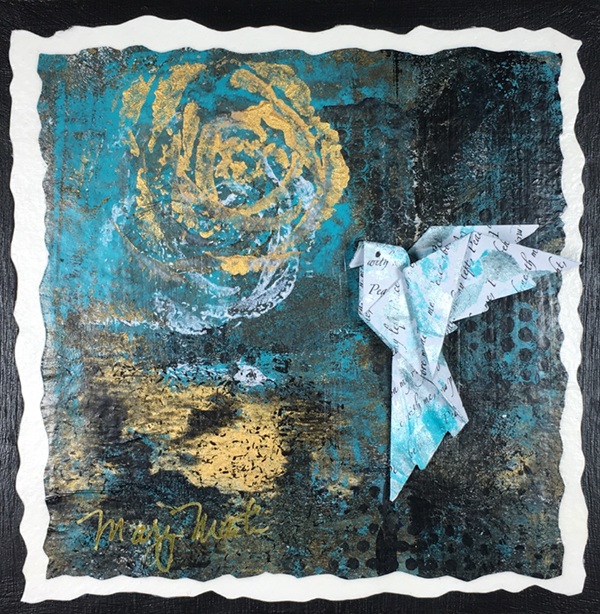
Channel of Peace II by Mary Martin
Inspirations
Mary’s body of work has evolved over the years. She is best known for her mixed media collages with organic deckled edges that incorporate painted tissue papers, sheet music, and handwritten scriptures. Working with themes of peace and joy expressed through scenes in nature, Martin begins each work by painting tissue paper and adding additional elements on top (e.g., painted origami doves) — creating tranquil landscapes, seascapes, and floral images. Then she adds imagery below through either music or other written words, where she will actually distort the music or written image to follow what’s going on in the painting. Her intent is “to create a space with the art where viewers can experience a moment of peace and joy within themselves.”
Her inspirations include the Impressionists—her favorite is Monet; nature – thanks to the influence of her father, who took Mary and her siblings to state parks for vacations, hikes, and rock picking in creeks; her faith; and peace. She sees herself as “a peacemaker” and regularly celebrates International Day of Peace (September 21) in her art and life.
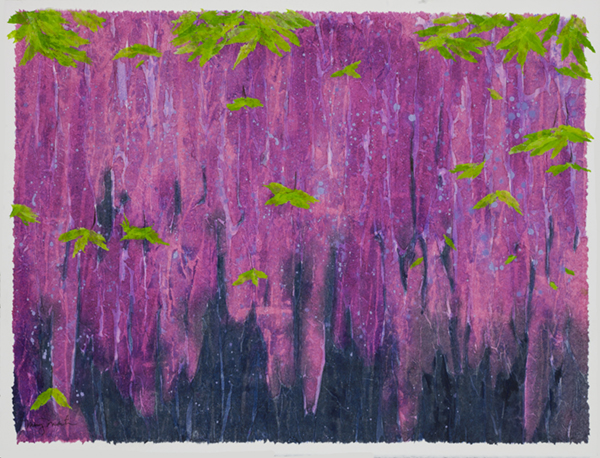
Wisteria Tune 2 by Mary Martin
Risks and Rewards
As an artist, Mary believes her biggest risk was “just putting it out there for somebody to say, is it good enough or not?” She remembers the first time she showed her work in an exhibit. “The waiting was the hardest part. Were they going to reject it or not?”
As a businesswoman, she was fortunate to have enough income from her husband and physical therapy work to buy her art supplies, build a body of work, and start selling without having to dip into the family’s operational funds. Purchasing the gallery has been her biggest risk to date because a loan was involved. This was the only time she’s had to borrow money for art.
For Mary, the most exciting part of being a gallery owner is working with the artists. Green Door Art Gallery hosts 30 resident artists per year with five guest artists rotating through the gallery every two months (with four artists displaying their work on the wall and one in the jewelry case.) That equates to 60 artists per year. “When I get guest artists in, they tend to be younger or more early in their careers,” says Mary. “I love seeing how excited they are to be in the gallery and how excited they are to make a sale, and especially when they make repeated sales – just so cool. The other thing is what a family our artists are, how supportive they are. All the resident artists are just as happy to see one of the other artists sell their art as they are selling their own. It’s so nice to see how supportive everyone is.”
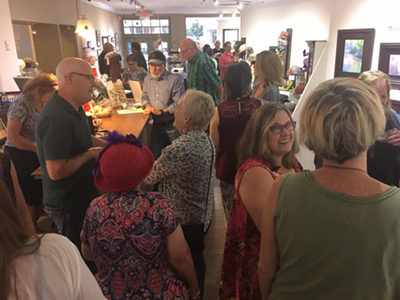
Gallery Night by Mary Martin
Upsides and Downsides of an Artist’s Life
The upsides of being an artist for Mary are the sheer joy of creation and putting her work out there to see if people will respond to it. “Not everybody’s art is for everyone,” she notes, “so part of the challenge is to determine who is your ideal audience and get your art in front of that audience.”
As for downsides, Mary cites “finding…no, MAKING…time to create your art and the rollercoaster ride associated with the burst of energy required to build a body of work; exhibit that work; then take a month or two before getting back into production mode.”
She also notes that some artists can process emotions through their artwork (for example, if they are angry, sad, or mad). However, Mary cannot use that same approach because she wants to bring out the peace and joy side of her work.
For new artists, particularly those in the second half of their lives, Mary offers the following recommendations:
- Find a way to play with your art. So many times, we want to have something we are specifically working on or have an idea about what the end should look like. Sometimes we forget that just working and playing creates more ideas.
- Often, inspiration comes while you’re creating and just playing. As artist Chuck Close has noted, “Inspiration is for amateurs; the rest of us just show up and get to work.”
- Go take a class. There are so many places to take one. We teach classes in watercolors, oils, drawing, and acrylics as well as multiple ways of doing things (e.g., pastels), all from different teachers. Say you start playing. You decide, “Oh I like watercolor.” Take another workshop from a watercolor artist whose work you admire — someone whom you would like to emulate, not imitate. Then, take another class from someone else who does things differently. Then figure out how to make it your own from there.
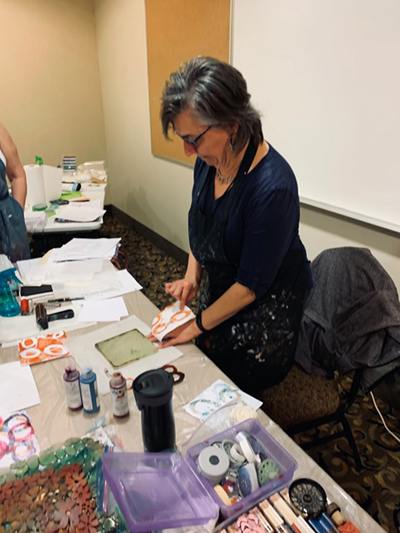
Monoprinting with Gel Printing Plate Workshop by Mary Martin
For more information about Mary Martin and her work as an artist, check out her website: www.marymartinartstudio.com You also can follow Mary on Instagram and Facebook.
To learn more about Green Door Art Gallery, you can visit her website https://www.greendoorartgallery.com/
The gallery’s latest exhibit is titled Life in Layers and runs from November 6 through December 29, 2019. She and the gallery’s artists regularly offer workshops ranging from two-hour to full-day classes, taught multiple times per year. Mary herself offers a gel printing plate workshop and, in fact, was recently a featured artist at the annual Gathering of Artisans in October 2019 in Black Mountain, NC.
